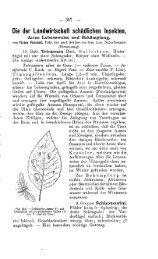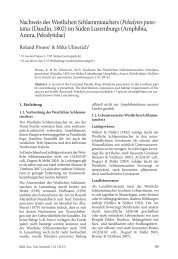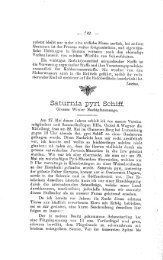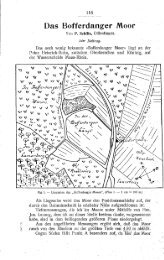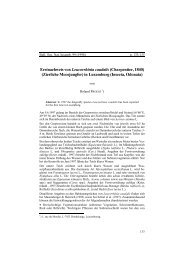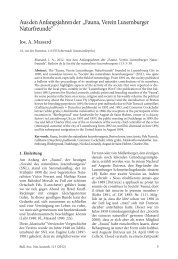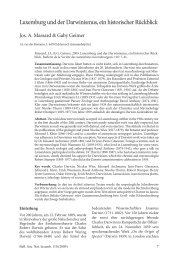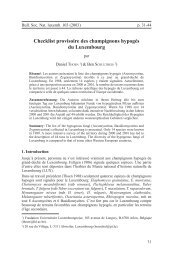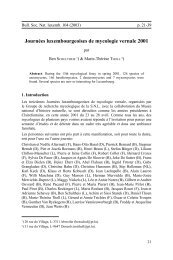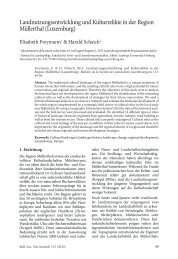Four new lichen-associated Trimmatostromaspecies ... - SNL
Four new lichen-associated Trimmatostromaspecies ... - SNL
Four new lichen-associated Trimmatostromaspecies ... - SNL
You also want an ePaper? Increase the reach of your titles
YUMPU automatically turns print PDFs into web optimized ePapers that Google loves.
olivaceo-brunneis, et partibus atrioribus paginae<br />
conidiorum minoribus in conidiis vetustioribus<br />
rimulosis.<br />
Type: Peru, Dep. La Libertad, Prov. Trujillo, Cerro<br />
Malabrigo, SW of Puerto Chicama, on saxicolous<br />
Lecanora, 100–150 m alt., 9 Apr. 1981, R. Santesson<br />
& A. Tehler P128:1 (UPS – holotype).<br />
Colonies <strong>lichen</strong>icolous, over the thallus and<br />
apothecia of a saxicolous Lecanora; when<br />
young, appearing as irregular, branched,<br />
blackish filaments (representing conidial<br />
chains), soon aggregating in very dense<br />
tufts of conidial chains, the infected parts of<br />
the host becoming entirely blackish. Mycelium<br />
internal, hyphae sparingly branched,<br />
1.5–3 µm wide, subhyaline to pale brown,<br />
septate, thin-walled, smooth. Stroma lacking.<br />
Conidiophores usually immersed, occasionally<br />
somewhat erumpent, micronematous,<br />
c. 20–40 × 2–4 µm, hyphal filaments<br />
gradually developing into fertile threads<br />
by becoming somewhat wider and darker,<br />
with slightly thicker wall, but differentiation<br />
between hyphae and conidiophores very<br />
difficult. Conidiogenous cells integrated, terminal,<br />
monoblastic (i.e., the terminal cell<br />
functioning as conidiogenous cell), c. 4–7<br />
× 3–4.5 µm, conidiogenous loci undifferentiated,<br />
subtruncate. Conidia in simple or<br />
rarely branched, irregular, easily disarticulating,<br />
basipetal chains, often subspherical<br />
and 1-septate, 6.5–10 × 6–8 μm, or oblong,<br />
transversely pluriseptate to dictyosporous,<br />
c. 11–24 × 5–9 µm, medium to dark brown,<br />
orange brown in KOH, wall 0.5–1.2 µm<br />
thick, rugose-rimulose to irregularly verrucose,<br />
ends more or less rounded.<br />
This species is readily distinguished from<br />
the other taxa treated here by conidial chains<br />
becoming orange brown in KOH, never with<br />
an olivaceous tinge, and by chains of disarticulating<br />
conidia. Furthermore, when the<br />
outer layer of the conidial wall splits with<br />
age, the resulting darker patches are often<br />
smaller than in the other species, giving the<br />
conidial surface a mosaic-like appearance.<br />
Ecology, host and distribution: This species<br />
is known only from the type collection<br />
made in Peru on an unidentified saxicolous<br />
Lecanora. Infected host thalli and apothecia<br />
are damaged, suggesting that the fungus is<br />
pathogenic.<br />
Trimmatostroma quercicola Diederich, U.<br />
Braun & Heuchert sp. nov. Figs 4–5<br />
MycoBank 518960.<br />
Trimmatostromatis dendrographae simile, sed<br />
catenis conidiorum macroscopice expedite conspicuis,<br />
irregulariter reticuloideis, conidiis badiis<br />
in aqua et olivaceo-brunneis in KOH, 5–15 µm<br />
latis, pariete usque ad 2 μm crasso. Differt a T.<br />
lecanoricola catenis conidiorum raro disarticulatis,<br />
conidiis olivaceo-brunneis in KOH, et strato<br />
exteriore conidiorum obscuriore in conidiis<br />
vetustioribus rimulosis.<br />
Type: Luxembourg, Vogelsmühle, valley of Halerbaach,<br />
left side of river, on bark of Quercus, possibly<br />
<strong>associated</strong> with sterile crustose <strong>lichen</strong>s, 9 Dec.<br />
2007, P. Diederich 16723 (BR – holotype; HAL,<br />
herb. Diederich – isotypes).<br />
Colonies over bark of Quercus, frequently<br />
overgrowing and probably parasitizing<br />
degenerate crustose <strong>lichen</strong> thalli or corticolous<br />
algae, effuse, loose to dense, fumoseblack,<br />
macroscopically appearing as relatively<br />
short, prostrate, irregularly formed<br />
and branched, often agglomerated conidial<br />
chains. Mycelium internal, hyphae sparingly<br />
branched, 1–3.5 µm wide, subhyaline to pale<br />
brown, septate, thin-walled, smooth. Stroma<br />
lacking. Conidiophores usually immersed,<br />
occasionally somewhat erumpent, micronematous,<br />
c. 5–40 × 2–6 µm, hyphal filaments<br />
gradually developing into fertile threads<br />
by becoming somewhat wider and darker,<br />
with slightly thicker wall, but differentiation<br />
between hyphae and conidiophores very<br />
difficult. Conidiogenous cells integrated,<br />
terminal, monoblastic (i.e., the terminal<br />
cell functioning as conidiogenous cell), c.<br />
5–10 × 3–4 µm, conidiogenous loci undifferentiated,<br />
subtruncate. Conidia in simple<br />
or rarely branched, irregular, occasionally<br />
disarticulating, basipetal chains, shape and<br />
size very variable, globose or subglobose,<br />
0–1(–2)-septate, 4–9 µm diam., or ellipsoidovoid,<br />
subcylindrical, oblong, 1–4(–5)-septate,<br />
transversely septate to dictyosporous, c.<br />
6–30 × 5–15 µm, sometimes forming irregular<br />
aggregations, medium to dark brown,<br />
olivaceous-brown in KOH, wall thick, up to<br />
2 µm, occasionally distinctly two-layered,<br />
i.e., with a distinct, paler inner layer (but not<br />
distoseptate), wall rugose-rimulose to irregularly<br />
verrucose, ends more or less rounded.<br />
52 Bull. Soc. Nat. luxemb. 111 (2010)



